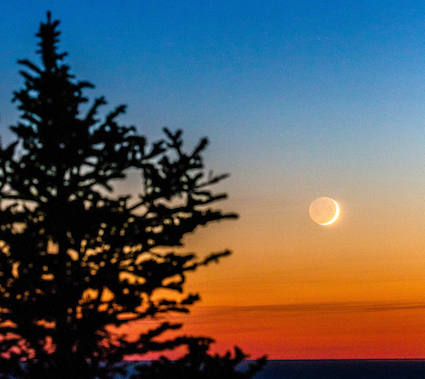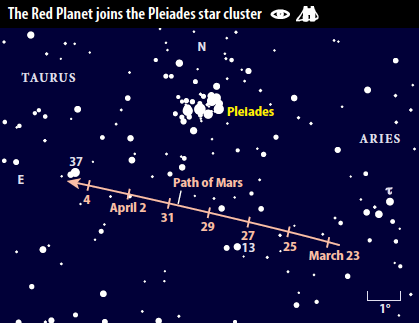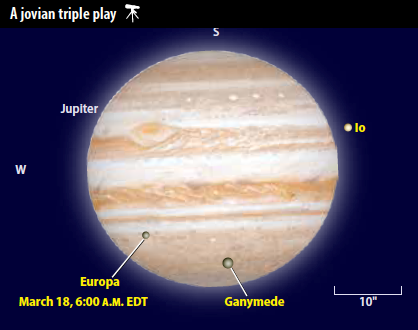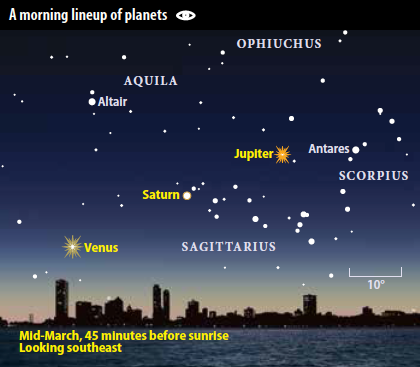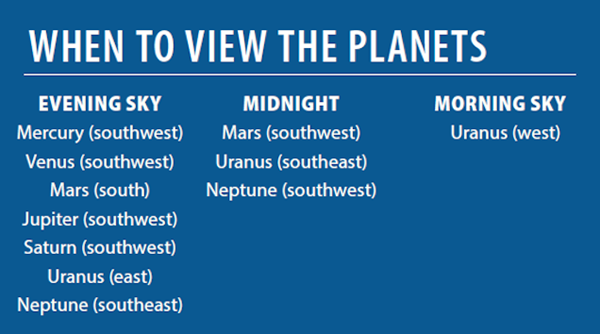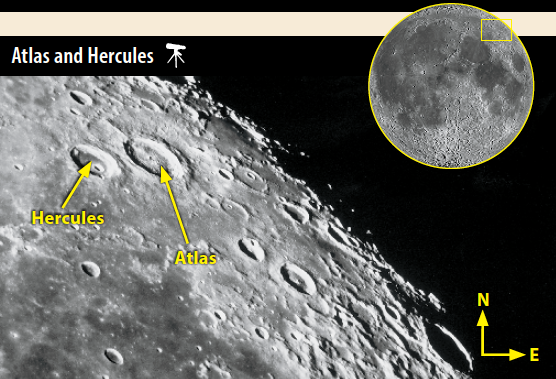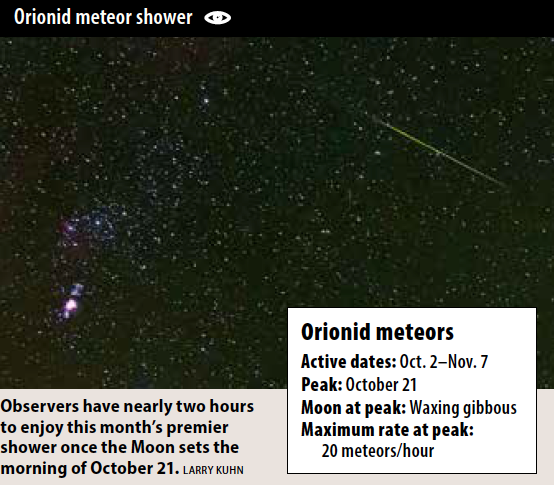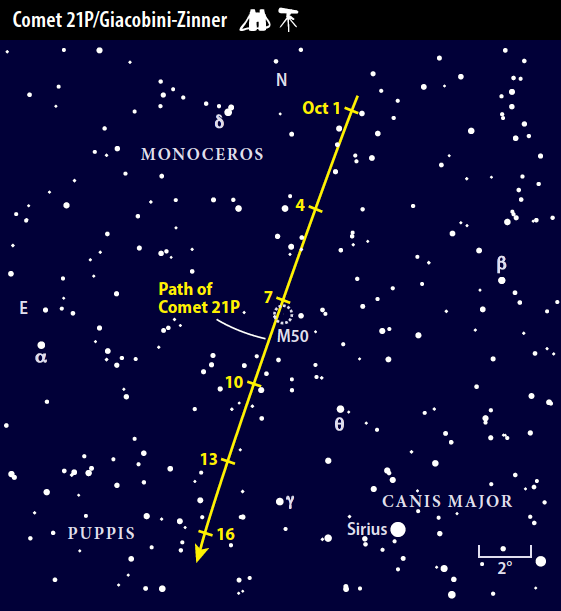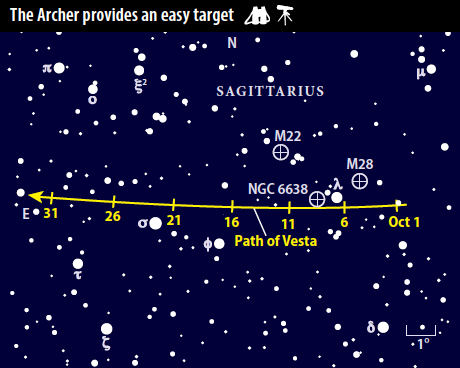Only two bright planets grace the evening sky this month. Mercury hangs low in twilight during March’s first week, while Mars rides high in the west after darkness falls all month. The best planet viewing occurs before daybreak, however, when Jupiter, Saturn, and Venus line up above the southeastern horizon.
The planet’s visibility worsens each day thereafter as it grows fainter and its orbit carries it closer to the Sun. You might catch the inner world through binoculars as late as the 7th, when it shines at 2nd magnitude and stands 3° high 45 minutes after sundown.
That same evening, look 9° to the planet’s left for a one-day-old Moon. The gossamer-thin crescent glows dimly but makes a beautiful sight against the twilight background. If you can’t find Luna on the 7th, try again on the 8th. It then lies 10° higher and shows a noticeably fatter — but still stunning — crescent phase. The Moon gains altitude quickly from night to night because the ecliptic — the apparent path of the Sun across the sky that the Moon and planets follow closely — makes a steep angle to the western horizon after sunset in early spring. It causes the Moon to gain 10° of altitude each evening despite moving only 11° eastward relative to the Sun.
The same geometry makes Uranus a tempting target during the first half of March. The ice giant world resides in southwestern Aries, a region that lies nearly 30° above the western horizon as darkness falls early this month. Uranus glows at magnitude 5.9, so you’ll need binoculars to see it well. First, locate 4th-magnitude Omicron (ο) Piscium in neighboring Pisces. Uranus lies 2.1° northeast of this star March 1. Don’t confuse the planet with the magnitude 5.9 star SAO 92659 just 0.2° away. The easiest way to tell them apart is to point a telescope at them. Only Uranus shows a distinctly blue-green disk, which measures 3.4″ across.
Unlike Uranus, Mars does a nice job of keeping ahead of the Sun during March. The Red Planet moves eastward relative to the background stars at nearly the same pace as our star, so it remains a fixture in the western evening sky all month. Even at the end of March, it doesn’t set until 11:30 p.m. local daylight time. And though the planet has faded dramatically since last summer’s peak, it still shines brightly at 1st magnitude.
Mars spends the first three weeks of March trekking eastward against the backdrop of southern Aries. It crosses the border into western Taurus on the 23rd, setting up a dramatic conjunction with the beautiful Pleiades star cluster (M45). The planet remains within the same binocular field as the cluster from March 23 until early April, and passes 3° south of it on the 29th and 30th.
Aldebaran, Taurus the Bull’s 1st-magnitude luminary, then lies 12° from Mars. The ruddy hues of the star and planet provide a nice contrast to the blue-white stars of the Pleiades.
While Mars looks wonderful with the naked eye or through binoculars, a telescope doesn’t add to its appeal. The Red Planet now lies on the far side of the solar system from Earth and shows a tiny disk just 5″ in diameter. Even the most experienced observers will have a hard time making out any features on the planet’s surface.
The solar system’s largest planet climbs some 25° above the horizon as twilight starts to paint the sky. That’s high enough to afford observers clear views through their telescopes. Even better, the giant world shows a large disk, whose diameter grows from 36″ to 40″ during March.
The first things you’ll see when viewing Jupiter are the gas giant’s two dark equatorial belts. These parallel cloud bands bracket a brighter zone that coincides with the planet’s equator. Observers recorded rich activity in these belts last year, and hope the trend continues in 2019.
Jupiter’s four bright moons prove equally fascinating. Although you typically can see them change relative positions within a couple of hours, it takes only a few minutes to perceive movement when the timing is right. For North American observers, the morning of March 18 provides just such an opportunity. Both Europa and Ganymede transit the gas giant’s disk while Io re-emerges from behind the planet. Europa starts the action when it touches Jupiter’s northeastern limb at 4:01 a.m. EDT, with Ganymede following at 5:04 a.m. Both satellites transit the planet’s northern hemisphere, with Europa closer to the equator. Ganymede is not even halfway across when Io reappears from behind Jupiter’s southeastern limb at 5:51 a.m.
Saturn rises just 15 minutes after the waning crescent Moon on March 1. Both objects clear the southeastern horizon by 4 a.m. local time. The two make a pretty sight an hour later, particularly if you view them under a dark sky with the glorious central regions of the Milky Way to their right and above. The Moon returns to Saturn’s vicinity March 29, when the planet rises about 10 minutes before its companion.
The ringed world shines at magnitude 0.6 among the background stars of Sagittarius. That’s more than a full magnitude brighter than any of the Archer’s stars, so you should have little difficulty identifying the solar system world. The planet drifts slowly eastward during the month, moving away from the constellation’s Teaspoon asterism.
While Jupiter and Saturn will grab viewers’ attention these March mornings, they pale in comparison to Venus. The brilliant planet shines at magnitude –4.1 in early March and fades only to magnitude –3.9 by month’s end. It rises within minutes of 4:30 a.m. local time (5:30 a.m. daylight time) all month, but at progressively more northerly locations along the eastern horizon. On the 31st, it rises 12° farther north than it did on the 1st. And be sure to pay attention March 13, when the three morning planets appear equally spaced.
After its close passage by Saturn on March 1, the waning crescent Moon greets Venus on the 2nd. The two rise together with less than 5° between them. One morning later, the Moon hangs 7° to Venus’ lower left, rising 30 minutes after the planet.
When viewed through a telescope, Venus shows a relatively small disk sporting a gibbous phase. The planet spans 16″ and appears 72 percent lit on the 1st. By the 31st, the inner world measures 13″ across and the Sun illuminates 81 percent of its Earth-facing hemisphere.
After a fine but brief appearance at dusk in early March, Mercury returns to view before dawn late in the month. On the 31st, the innermost planet appears 4° high in the east 30 minutes before sunrise. It shines at magnitude 0.9 and will be difficult to see in the brightening sky without binoculars. Your best bet is to center on Venus and then scan to the lower left, toward where twilight glows brightest. If you turn a telescope on Mercury, you’ll find a 9″-diameter disk that appears one-quarter lit.
Neptune passes behind the Sun from our vantage point March 6 and remains hidden in our star’s glare all month. It will return to view before dawn in late April, though just barely.
First-time observers of the Moon typically come away from the telescope’s eyepiece marveling at our satellite’s rugged landscape. Perhaps no feature embodies this impression better than Rupes Recta — the Straight Wall. This treasure takes the form of a long black blade extending from its hilt. Rupes Recta appears best this month the evening of March 14, just after First Quarter phase. It lies on a relatively flat lava plain near the center of a large, half-buried crater on the eastern shore of Mare Nubium (Sea of Clouds).
The Straight Wall’s very name conjures images of a cliff, but it has a slope of only 12° to 20° — a decent grade for driving but not for tobogganing. The Wall stretches about 70 miles long and 1.5 miles wide, but rises only some 1,300 feet above the surrounding plain. It likely formed once the lava that flooded Mare Nubium started to cool, causing the terrain to sink and pull westward away from the land to the east. You’ll see Mare Nubium better March 15 once the Sun climbs higher in the lunar sky, but the shadow that makes the Straight Wall stand out shrinks by then.
Thanks to the long shadows on the 14th (longer than those in the accompanying photo), Rima Birt is also ripe for viewing. It won’t be easy to see this intriguing, worm-shaped channel extending north of Birt Crater, so use the highest power viewing conditions allow and some patience to trace out this groove.
March typically proves to be a quiet month for meteor observers. No major showers occur, and the only minor ones are best seen from the Southern Hemisphere. Still, viewers should keep their eyes to the sky for occasional sporadic meteors that appear from random directions and rare fireballs that shine at least as bright as Venus.
You might also spot two or three meteors per hour coming from the “antihelion” (opposite the Sun) direction. This broad region stretches roughly 30° east to west and 15° north to south, and it is centered on the ecliptic about 12° east of our star’s opposition point. In March, this radiant lies in southern Virgo.
Astronomers think the antihelion source is a relic of many ancient meteor showers that have dwindled to a light sprinkle of a couple of meteors per hour.
Comet 46P/Wirtanen put on an impressive show in December, when it rose to naked-eye visibility as it passed between the Pleiades and Hyades star clusters. Now, three months later, Wirtanen has faded dramatically. Barring an outburst, it should glow around 10th magnitude in early March. That would put it in range of a 4-inch telescope under a dark sky.
During this period, Wirtanen journeys from southern Ursa Major into northern Leo Minor. This nondescript region lies high in the east after darkness falls and passes nearly overhead before midnight local time. To locate the comet, first find Mu (μ) and Lambda (λ) Ursae Majoris, the 3rd-magnitude stars that mark the Great Bear’s middle paw. Then head 5° west of Mu to 5th-magnitude 19 Leonis Minoris, the brightest star on the finder chart at right. From there, carefully star-hop to the indicated position.
Carl Wirtanen discovered this comet in 1948. It takes 5.44 years to orbit the Sun, but each time the comet returns to the inner solar system, Earth is in a different place. The Sun, Earth, and comet lined up nearly perfectly in December, making this apparition about as good as possible.
Asteroid 3 Juno rarely enjoys a four-month run of good visibility, so it’s worth taking advantage of this opportunity. Only two other asteroids currently outshine it, and neither is as nicely placed. You can find Juno crossing Orion’s Shield, which lies halfway from the southwestern horizon to the zenith after the sky grows dark.
Modern go-to telescopes can get you to Juno’s position quickly, but you’ll still need to compare your field of view to the chart below to identify the 9th-magnitude asteroid from background stars. To search more traditionally, sketch the field and come back a couple of hours later to see which “star” shifted position.
March provides several chances to see such a displacement. The best window runs from the 11th to 18th, when Juno crosses the Hunter’s Shield and slinks past the star cluster NGC 1662. Pay particular attention March 16, when the asteroid passes 0.1° north of 5th-magnitude Pi1 (π1) Orionis.
Juno spans 170 miles and orbits in the main asteroid belt between Mars and Jupiter. The current apparition peaked last November, when Juno shone brighter than it had in 35 years.

